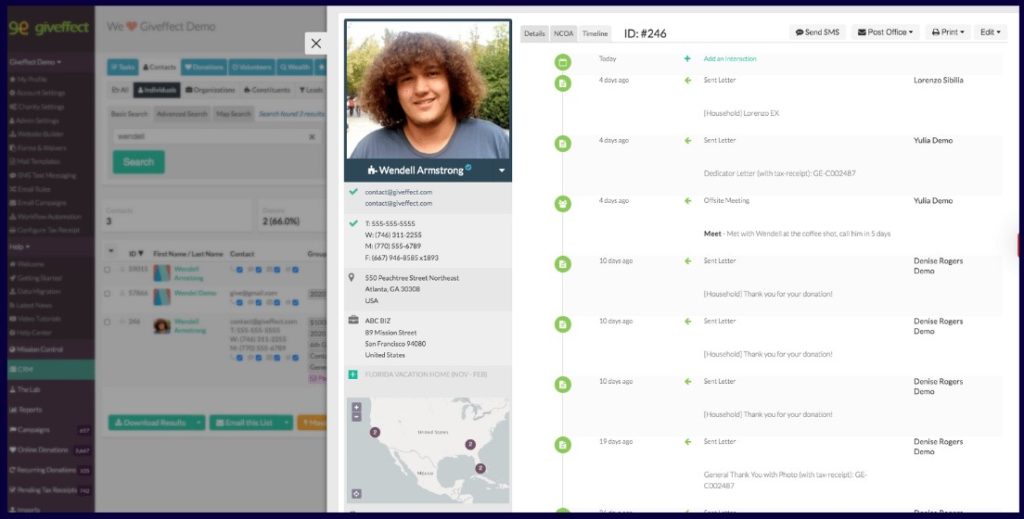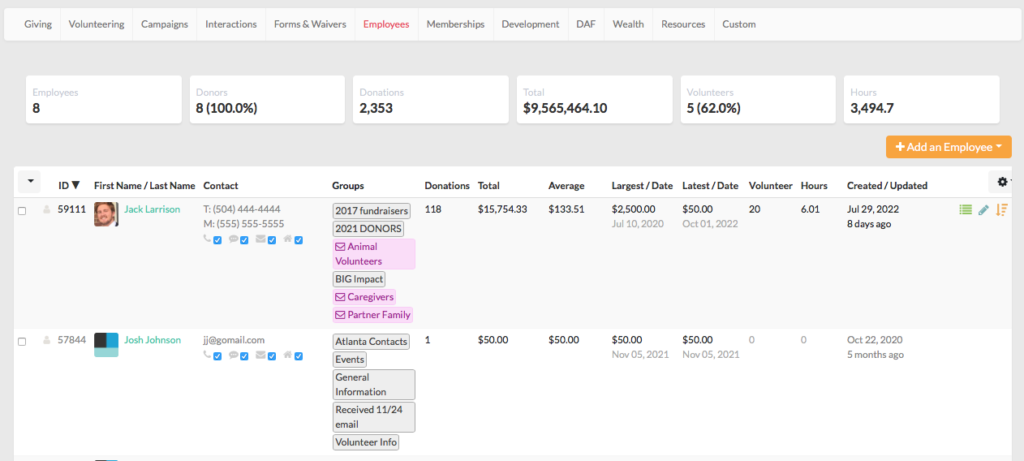Meeting year-end fundraising goals is on every nonprofit development professional’s mind right now. To help you reach your goals and not leave funds from individuals or corporations on the table, we’ve teamed up with one of our integration partners, Double the Donation.
In this action-oriented chat, Jack Harrison, Giveffect Client Success Team Manager, and Grace Green, Double the Donation Partnership Success Specialist, share their winning strategies to increase individual and corporate contributions this Giving Season.
Key Takeaways:
1. Personalize and Segment Your Year-End Supporters
Personalization helps your organization cut through the noise during one of the busiest fundraising times of the year! Personalization and segmentation allow your organization to engage in donor-centric fundraising—effectively building lasting, meaningful relationships.
Potential Supporter Groups to Segment by:
- Major Donors
- Recurring Donors
- Volunteers
- Matching Gift Eligible Donors
- Lapsed Donors
- LYBUNT/SYBUNT Donors
- Social Media Followers
Additionally, segments don’t have to be siloed groups of people. When thinking about end-of-year giving, don’t limit yourself to donation history. Instead, use your CRM to look at those who have engaged with your nonprofit in different ways. For example, Volunteers are some of your most engaged supporters. Query for volunteers who also attended specific events. And look at which constituents engaged with specific communications your communication—direct mail, email, or SMS—to segment by topics and communication channels of interest.
Pro Tip: If the tools you use allow for this, such as Giveffect, save your queries to identify these segments in seconds. With Giveffect, you can also use filters to create “Groups” to easily identify relationships and interests on both an individual’s account level and at the Group level. Groups help us draw pictures with our data to get the most out of it.
Let Technology do the Work
- Lean on your technology and automation to help you better understand your supporters and craft the perfect messaging for your segmented outreach.
- Effectively tracking and segmenting your supporters in your CRM allows you to maintain meaningful relationships while also being efficient and maximizing your resources.
- Some systems out there, like Giveffect, have tools within them to automate your workflows.
For example, you want to send a certain year-end appeal to those who attended a specific event or perhaps gave a gift over a certain amount. Instead of manually performing each step in the process to collect that data and send the communications, which can be quite time-consuming and prone to errors, use automation workflows within Giveffect. Simply set the filters you want your CRM to track, and then the communications will automatically send by the rules you set. Using automation workflows like this can give you a lot of time back in your day and help you send personalized communications to your supporters rather than losing hours while stuck manipulating a complicated spreadsheet.
Best Practice: Now, if you don’t have a tool to do this for you automatically. At the very least, set aside time throughout the year, perhaps even monthly, to set up and run reports to have this data at your fingertips. Without automation, it will be a more manual task, however, many CRMs do let you save the reports or queries you are creating. Don’t waste time building your reports over and over and over again if you don’t need to.
Pro Tip: You likely know a lot more about your donors than you think. Their birthday. Where they work. Which communications they open. Depending on the tools you are using, you can track these interactions to gain a full engagement history with your donors. This image is an example of a supporter profile and the journey this supporter has been on with your organization, including when letters and emails are sent, events are attended, etc.

2. Capitalize on Existing Corporate Partnerships.
Corporate Social Responsibility (CSR) initiatives are becoming increasingly important among companies, so encourage your existing corporate partners or sponsors to take it one step further or engage in a new way.
Common types of sponsorships:
- Financial
- In-kind
- Event
- Promotional
The end of the year is also a great time to get in front of your existing corporate partners in a new way.
- Coordinate an exclusive end-of-year campaign for employees
- Organize a company-wide volunteer day
- Invite employees to participate in upcoming events
- Remind employees of workplace giving opportunities
Below is an example of an Employee view from within Giveffect. If you have a relationship with an organization or company like Bank of America or Home Depot, you can easily track employees as their own contact profiles and their relationship with their employer within your CRM. So whether you want to know where a specific constituent works or which constituents work for a specific company, the information is organized for you to fully leverage.

It’s important to note that people do move jobs frequently, especially nowadays. This necessitates having up-to-date information. When you can track these relationships, it makes it much easier to communicate, and you can organize your outreach based on the information you know.
3. Set a Year-End Fundraising Goal and Share It.
This is a bit of a controversial topic. Many organizations shy away from sharing their set goal openly for fear of not reaching it. Once you’ve set a goal for your end-of-year fundraising campaign, consider sharing it with your audience. People are often more motivated to give when a goal is close to being reached. They want to be the one who helps your organization cross the fundraising finish line. Find what works for your organization here – fundraising thermometer, weekly newsletter updates on your progress, social media posts, etc.
When you reach your goal, be sure to follow up accordingly to highlight those who helped make it happen:
- Thank any and all supporters (no matter the gift size)
- Donor Walls
- Social Media Thank You Campaigns
- Showcase the impact of their donation
Don’t limit yourself in terms of methods of communication. Instead, meet people where they are. Don’t limit yourself to email or direct mail. Incorporate SMS and social media to reach younger audiences. Use what you know about your donors to reach them. Consider how they have engaged in past campaigns. And, of course, we want to do this on the acknowledgment side as well. It’s not just about thanking them for their generosity, it’s about fostering that “community” connection. As today’s virtual world continues to expand, there is an opportunity to grow virtual communities and reach wider audiences than just those in your local community.
Pro Tip: You may not always reach your goal, and that’s okay! Be transparent with your supporters and use this as a push for the rest of your end-of-year giving.
4. Follow Up on Corporate Matching Gifts.
The biggest barrier to receiving matching gift funds is a lack of donor awareness, resulting in $4-7 billion in matching gift revenue going unclaimed annually. An incredible stat is that 78% of match-eligible donors have no idea whether their employer offers a matching gift program. Over 26 million individuals are eligible for matching gifts but are likely unaware.
So what can you do to capture these funds? Encourage your donors to check their eligibility and pursue a matching gift. Most corporate matching gift programs have a submission deadline timed around the calendar year, so the end-of-year giving season is the perfect time to follow up with donors from earlier in the year.
Simplify the matching gift process as much as possible with direct, personalized calls to action.
- Step 1: Individual donates to a nonprofit
- Step 2: Individual checks eligibility for a company gift match
- Step 3: Individual submits a request for a gift match
- Step 4: Company reviews the match request
- Step 5: Company matches the donation
Best Practice: Capture employment information directly on your donation form. Then, you can easily provide your supporters with personalized, actionable next steps after they’ve completed their donation!
With Giveffect, since we do partner with Double the Donation, an employer dropdown is directly available in the donation checkout form. Since you are capturing this information, and follow-up work isn’t as strenuous. Supporters can type in their employer’s name and see if they are listed as in the example below.

With your current tools, you may not have this kind of direct integration, so your follow-up to find out employer information is done after folks give.
Some employees may not even know that their employer offers a giving matching program, so including this in the checkout flow can spark that question of “wait, what about where I work?”
Best Practice: Follow up with donors post transaction about their matching gift eligibility. Include matching gifts in your other email campaigns as well.
Pro Tip: Recurring donations can still be eligible for matching gifts. Encourage your monthly donors to check their eligibility and batch their donations at the end of the year!
5. Get Creative with Your Year-End Outreach.
Nonprofits everywhere are vying for attention at the end of the year and on Giving Tuesday, so be sure to differentiate your outreach on and leading up to November 29th. Know your audience and tailor your plan accordingly—social media, direct mail, and phone calls.
You may also want to leverage resources from the creators of GivingTuesday themselves.
Ideas and resources to get you started:
- Celebrate generosity and highlight what your organization can do with an individual’s support
- Canva for Nonprofits is free and gives you premium access to easily create beautiful graphics and materials. Plus, GivingTuesday offers free Canva templates.
- Send your supporters a GivingTuesday calendar invite to hold the day of giving on their personal calendars.
- Provide social media graphics and CTAs after the donation, so your supporters can spread the word!
If you’re interested in learning more about how Giveffect can help you execute these 5 year-end strategies to increase individual and corporate contributions, schedule a call today!